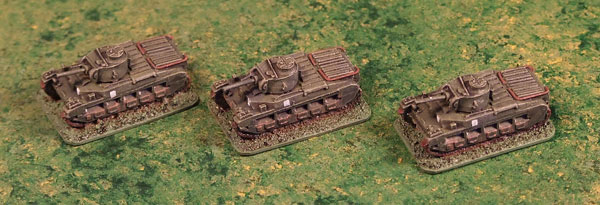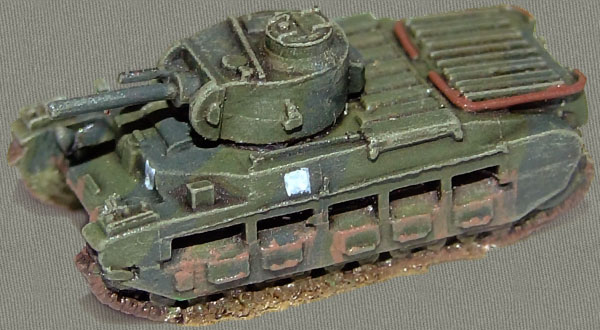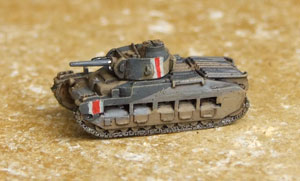


Manufacturer: C-in-C Microarmour
Genre: 1/285th WWII Wargaming
Comments: I've painted these Matildas in the Middle Bronze Green scheme used for British armour during the Battle of France in 1940. The middle one has also had a Deep Bronze Green disruptive pattern painted over it (you can make it out in the enlargement, but it's hardly visible at all at arms length) but as with the original paint scheme, the contrast between the two colours is so low as to be practically worthless as a disruptive camouflage scheme, and I didn't bother with the other two.

The large white square painted on the hull sides (and also front and rear) was a BEF recognition symbol. It was, understandably, not tremendously popular with the men who actually had to drive the tanks into battle since it makes a perfect aiming mark for anti-tank gunners.
Quite a few were sent to the Soviet Union as lend-lease equipment, though the well-protected running gear proved to be too complex and fragile for Russian conditions.
This is the first time I've based any vehicles; I'm not really in favour of it for aesthetic reasons. However, I've found that by using thin galvanised steel as a basing material, I can store and carry the models on flexible magnetic sheet of the sort used for fridge magnets and the like. The models are thus easily accessible, and don't slide around getting chipped and bent.


Manufacturer: C-in-C
Genre: 1/285th WWII Wargaming
Comments: This infantry tank was known for a time as the "Queen Of The Desert" because of its reliability, and because its armour was sufficient to shrug off hits from any German tank or anti-tank gun except the 88mm flak until they introduced the long-barrelled 50mm KwK L60 and 75mm KwK L48. Slow and under-gunned, the Matilda was soon outclassed by newer German tanks with bigger guns and heavier armour.
This model has been painted in the early-war "Caunter" pattern for the Western Desert. I've had very little luck finding online pictorial references for Caunter schemes, so I've just taken a guess as to how it might have been applied to the upper surfaces of the tank.
